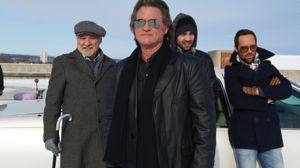You certainly had a lot of disparate elements to work with in Jonathan Sobol's caper The Art of the Steal (2013). Scenery-chewing bit characters, chronological reshuffling, heavy use of voiceover - they all provide editing challenges. So how do you string it all together? In your case, you artfully steal from one of the most successful heist films in the past decade - Ocean's 11.
That's not necessarily a bad thing. It's obvious you dipped into Stephen Mirrione's toolbox of wipe-cuts, split screens and generally busy editing. This approach keeps things humming along, even if you could have held some shots on the actors a bit longer to mine more emotional tension. I guess you were too busy cutting around all the camera-mugging thespians (Jay Baruchel, Jason Jones, and Terrence Stamp). But as a result, The Art of the Steal too often sacrifices characters for style.
It doesn't help that Sobol's story is overbloated. Crunch Callaghan (Kurt Russel) was betrayed by his brother Nicky (Matt Dillon) on an art robbery seven years ago. Since getting out of prison, Crunch has been living out his misspent existence doing motorcycle stunts in Quebec City. Inevitably, through Nicky's ongoing double-crossing, Crunch gets back into the game, and the old team gets reassembled (including an out-of-place Kenneth Welsh as a genial Irishman named Paddy) for one last daring heist. Sounds straightforward enough, but as the double- and even triple- crossing mount up towards the third act, you wish Sobol had gone for simplicity over cleverness.
Granted, the main problem lies in the screenplay. There isn't much an editor can do vis-a-vis character development when the first act is dominated by voiceover telling us how everyone met. I'm sure you could have put together a great moment when Crunch catches Baruchel's Francie stealing his hubcaps only to give him a shot working as his apprentice. Instead, we have Kurt Russel telling us about it, while you cut crisply around shots of him donning his wheelman gear. I felt cheated - you probably did too.
Maybe it was a budgeting issue. I definitely felt the limited scope and scale with so few establishing shots of the various settings. The story jumps around from Warsaw to Quebec, Detroit to Niagara Falls. Aside from the warm yellowish hues of Warsaw, it's hard to tell the cool-blue locations apart.
It was obvious, at least, that you didn't want to waste the audience's time. In the end, you stitched together a decent way to spend 90 minutes.







